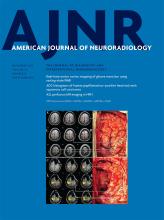Index by author
Gong, X.
- EDITOR'S CHOICEFunctionalOpen AccessReal-Time Motor Cortex Mapping for the Safe Resection of Glioma: An Intraoperative Resting-State fMRI StudyT.-m. Qiu, F.-y. Gong, X. Gong, J.-s. Wu, C.-p. Lin, B.B. Biswal, D.-x. Zhuang, C.-j. Yao, X.-l. Zhang, J.-f. Lu, F.-p. Zhu, Y. Mao and L.-f. ZhouAmerican Journal of Neuroradiology November 2017, 38 (11) 2146-2152; DOI: https://doi.org/10.3174/ajnr.A5369
The authors conducted preoperative and intraoperative resting-state intrinsic functional connectivity analyses of the motor cortex in 30 patients with brain tumors. Factors that may influence intraoperative imaging quality, including anesthesia type and tumor cavity, were studied. Additionally, direct cortical stimulation was used to validate the accuracy of intraoperative resting-state fMRI in mapping the motor cortex. Fourteen patients who successfully completed both sufficient intraoperative resting-state fMRI and direct cortical stimulation were used for further analysis of sensitivity and specificity. Compared with those subjected to direct cortical stimulation, the sensitivity and specificity of intraoperative resting-state fMRI in localizing the motor area were 61.7% and 93.7%, respectively. They conclude that using intraoperative resting-state fMRI can avoid the risk of intraoperative seizures due to direct cortical stimulation and may provide neurosurgeons with valuable information to facilitate the safe resection of gliomas.
Ha, E.J.
- FELLOWS' JOURNAL CLUBNeurointerventionYou have accessComparison of Clinical Outcomes of Intracranial Aneurysms: Procedural Rupture versus Spontaneous RuptureH.H. Choi, E.J. Ha, J.J. Lee, D.H. Yoo, W.-S. Cho, J.E. Kim, Y.D. Cho, M.H. Han and H.-S. KangAmerican Journal of Neuroradiology November 2017, 38 (11) 2126-2130; DOI: https://doi.org/10.3174/ajnr.A5344
This was a retrospective review of 1340 patients with 1595 unruptured saccular intracranial aneurysms that underwent endovascular coil embolization between February 2010 and December 2014. The clinical outcomes of patients with procedural rupture of saccular intracranial aneurysms were compared with those of 198 patients presenting with spontaneously ruptured aneurysms. Procedural rupture developed in 19 patients, and the morbidity related to procedural rupture was 26.3% with no mortality. Hunt and Hess scale grades and hospitalization days of patients with procedural rupture were equivalent to those of patients presenting with spontaneous aneurysm rupture. In multivariate analysis, spontaneous aneurysm rupture was a significant risk factor for worse clinical outcome. This study showed better clinical outcomes in the procedural-rupture group.
Hamzei-sichani, F.
- EDITOR'S CHOICENeurointerventionOpen AccessAngioarchitectures and Hemodynamic Characteristics of Posterior Communicating Artery Aneurysms and Their Association with Rupture StatusB.J. Chung, R. Doddasomayajula, F. Mut, F. Detmer, M.B. Pritz, F. Hamzei-Sichani, W. Brinjikji, D.F. Kallmes, C.M. Jimenez, C.M. Putman and J.R. CebralAmerican Journal of Neuroradiology November 2017, 38 (11) 2111-2118; DOI: https://doi.org/10.3174/ajnr.A5358
The authors studied 313 posterior communicating artery aneurysms (145 ruptured, 168 unruptured) with image-based computational fluid dynamics. Aneurysms were classified into different angioarchitecture types depending on the location of the aneurysm with respect to parent artery bifurcation. Ruptured aneurysms had higher, more concentrated, and more oscillatory wall shear stress distributions; stronger and more concentrated inflow jets; and more complex and unstable flow patterns compared with unruptured aneurysms. They conclude that high-flow intrasaccular hemodynamic characteristics, commonly found in bifurcation-type angioarchitectures, are associated with the posterior communicating artery aneurysm rupture status.
Han, M.H.
- FELLOWS' JOURNAL CLUBNeurointerventionYou have accessComparison of Clinical Outcomes of Intracranial Aneurysms: Procedural Rupture versus Spontaneous RuptureH.H. Choi, E.J. Ha, J.J. Lee, D.H. Yoo, W.-S. Cho, J.E. Kim, Y.D. Cho, M.H. Han and H.-S. KangAmerican Journal of Neuroradiology November 2017, 38 (11) 2126-2130; DOI: https://doi.org/10.3174/ajnr.A5344
This was a retrospective review of 1340 patients with 1595 unruptured saccular intracranial aneurysms that underwent endovascular coil embolization between February 2010 and December 2014. The clinical outcomes of patients with procedural rupture of saccular intracranial aneurysms were compared with those of 198 patients presenting with spontaneously ruptured aneurysms. Procedural rupture developed in 19 patients, and the morbidity related to procedural rupture was 26.3% with no mortality. Hunt and Hess scale grades and hospitalization days of patients with procedural rupture were equivalent to those of patients presenting with spontaneous aneurysm rupture. In multivariate analysis, spontaneous aneurysm rupture was a significant risk factor for worse clinical outcome. This study showed better clinical outcomes in the procedural-rupture group.
Heit, J.J.
- NeurointerventionYou have accessPatient Outcomes and Cerebral Infarction after Ruptured Anterior Communicating Artery Aneurysm TreatmentJ.J. Heit, R.L. Ball, N.A. Telischak, H.M. Do, R.L. Dodd, G.K. Steinberg, S.D. Chang, M. Wintermark and M.P. MarksAmerican Journal of Neuroradiology November 2017, 38 (11) 2119-2125; DOI: https://doi.org/10.3174/ajnr.A5355
Heyn, C.
- Adult BrainYou have accessDetection of Volume-Changing Metastatic Brain Tumors on Longitudinal MRI Using a Semiautomated Algorithm Based on the Jacobian Operator FieldO. Shearkhani, A. Khademi, A. Eilaghi, S.-P. Hojjat, S.P. Symons, C. Heyn, M. Machnowska, A. Chan, A. Sahgal and P.J. MaralaniAmerican Journal of Neuroradiology November 2017, 38 (11) 2059-2066; DOI: https://doi.org/10.3174/ajnr.A5352
Hill, J.
- Head and Neck ImagingYou have accessPrevalence of Internal Auditory Canal Diverticulum and Its Association with Hearing Loss and OtosclerosisK.J. Pippin, T.J. Muelleman, J. Hill, J. Leever, H. Staecker and L.N. LedbetterAmerican Journal of Neuroradiology November 2017, 38 (11) 2167-2171; DOI: https://doi.org/10.3174/ajnr.A5399
Hills, N.K.
- Pediatric NeuroimagingOpen AccessClinical and Imaging Characteristics of Arteriopathy Subtypes in Children with Arterial Ischemic Stroke: Results of the VIPS StudyM. Wintermark, N.K. Hills, G.A. DeVeber, A.J. Barkovich, T.J. Bernard, N.R. Friedman, M.T. Mackay, A. Kirton, G. Zhu, C. Leiva-Salinas, Q. Hou, H.J. Fullerton and the VIPS InvestigatorsAmerican Journal of Neuroradiology November 2017, 38 (11) 2172-2179; DOI: https://doi.org/10.3174/ajnr.A5376
Hisanaga, S.
- Adult BrainYou have accessPituitary Macroadenoma and Visual Impairment: Postoperative Outcome Prediction with Contrast-Enhanced FIESTAS. Hisanaga, S. Kakeda, J. Yamamoto, K. Watanabe, J. Moriya, T. Nagata, Y. Fujino, H. Kondo, S. Nishizawa and Y. KorogiAmerican Journal of Neuroradiology November 2017, 38 (11) 2067-2072; DOI: https://doi.org/10.3174/ajnr.A5394
Hoffman, C.
- Pediatric NeuroimagingYou have accessVolume of Structures in the Fetal Brain Measured with a New Semiautomated MethodR. Ber, D. Hoffman, C. Hoffman, A. Polat, E. Derazne, A. Mayer and E. KatorzaAmerican Journal of Neuroradiology November 2017, 38 (11) 2193-2198; DOI: https://doi.org/10.3174/ajnr.A5349








